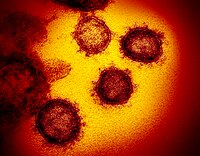
Photo from wikipedia
The diagnosis of sleep disordered breathing depends on the detection of respiratory-related events: apneas, hypopneas, snores, or respiratory event-related arousals from sleep studies. While a number of automatic detection methods… Click to show full abstract
The diagnosis of sleep disordered breathing depends on the detection of respiratory-related events: apneas, hypopneas, snores, or respiratory event-related arousals from sleep studies. While a number of automatic detection methods have been proposed, their reproducibility has been an issue, in part due to the absence of a generally accepted protocol for evaluating their results. With sleep measurements this is usually treated as a classification problem and the accompanying issue of localization is not treated as similarly critical. To address these problems we present a detection evaluation protocol that is able to qualitatively assess the match between two annotations of respiratory-related events. This protocol relies on measuring the relative temporal overlap between two annotations in order to find an alignment that maximizes their F1-score at the sequence level. This protocol can be used in applications which require a precise estimate of the number of events, total event duration, and a joint estimate of event number and duration. We assess its application using a data set that contains over 10,000 manually annotated snore events from 9 subjects, and show that when using the American Academy of Sleep Medicine Manual standard, two sleep technologists can achieve an F1-score of 0.88 when identifying the presence of snore events. In addition, we drafted rules for marking snore boundaries and showed that one sleep technologist can achieve F1-score of 0.94 at the same tasks. Finally, we compared this protocol against the protocol that is used to evaluate sleep spindle detection and highlighted the differences.
Journal Title: IEEE Journal of Biomedical and Health Informatics
Year Published: 2022
Link to full text (if available)
Share on Social Media: Sign Up to like & get
recommendations!